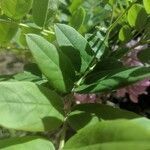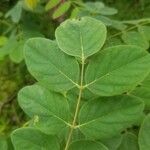Shrubs, 1-3 m tall, deciduous. Young branches green, densely appressed purple scabrous glandular hairy and white pilose; biennial branches dark gray-brown, densely brown bristly, 2-5 mm. Leaves 15-30 cm; rachis appressed bristly and white curled pubescent, adaxially grooved; petiolule appressed white pubescent; stipel aristiform, persistent; leaflets 5-7(or 8) pairs; leaflet blades elliptic, ovate, broadly ovate, or suborbicular, 1.8-5 × 1.5-3.5 cm, often basal pair of leaflets on rachis smaller, glabrous, abaxially grayish green, adaxially dark red when young but later turning green, midvein abaxially with sparse appressed trichomes, base rounded, apex rounded and aristiform. Racemes axillary, all but corolla appressed purple glandular hairy and white pubescent, 3-8-flowered; peduncle 4-8.5 cm; bracts ovate-lanceolate, 5-6 mm, caducous, sometimes apical ones 3-lobed, apex gradually caudate. Calyx purple, obliquely campanulate; tube ca. 5 mm; teeth triangular, 3-6 mm, apex caudate to subulate. Corolla red to rosy. Petals stipitate; standard subreniform, ca. 2 × 3 cm, apex with a sinus; wings falcate, ca. 2 cm, auriculate; keel nearly triangular, ca. 1.5 cm, apex rounded, connate at leading edge, auriculate. Stamens diadelphous, one opposite to standard free; anthers elliptic. Ovary subterete, ca. 1.5 cm, with densely appressed adenose papillae, faintly pilose along sutures, many ovuled; stigma terminal. Legume linear, 5-8 × 8-12 mm, compressed, 3-5-seeded, with dense appressed bristles, carpopodium short, apex acute. Fl. May-Jun, fr. Jul-Oct.
More
Rhizomatous shrub 1–2(–3) m; stems, peduncles, and cal densely to sparsely hispid with glandular hairs 2–5 mm, those of the stem tending to persist and become indurate; lfls 7–13, ovate-oblong to subrotund, 3–6 cm; racemes usually 3–10-fld; fls rose or pink-purple, 2.5–3 cm; ovary densely glandular; fr densely hispid. Mt. woods; Va. and Ky. to Ga. and Ala., sometimes escaped from cult. as far n. as Me. and Minn. June, July. The common var. hispida is triploid (2n=30) and fruits poorly or not at all (the frs often formed, but nearly or quite seedless); the rare var. fertilis (Ashe) R. T. Clausen, probably not native with us, is diploid and fertile (2n=20). Var. fertilis is being grown as ground cover on mine spoil etc. in Pa. Vigorous subglabrous triploids, native from sw. Va. to N.C. and n. Ga., sometimes cult. elsewhere, have been called var. rosea Pursh; an origin through hybridization with R. pseudoacacia has been suggested.
A shrub or small tree. It grows 2-4 m tall. The stems are bristly and sticky to touch. The leaves are 12-23 cm long and have 7-15 leaflets along the stalk. The leaflets are 2-5 cm long. The flowers are pink. They are in groups of 3-12 together.







